Art Fairs
Our Complete Guide to Frieze LA and the Other Fairs Opening in Tinseltown Next Week
LA is getting a bona fide international fair week, just in time for Valentine's Day.
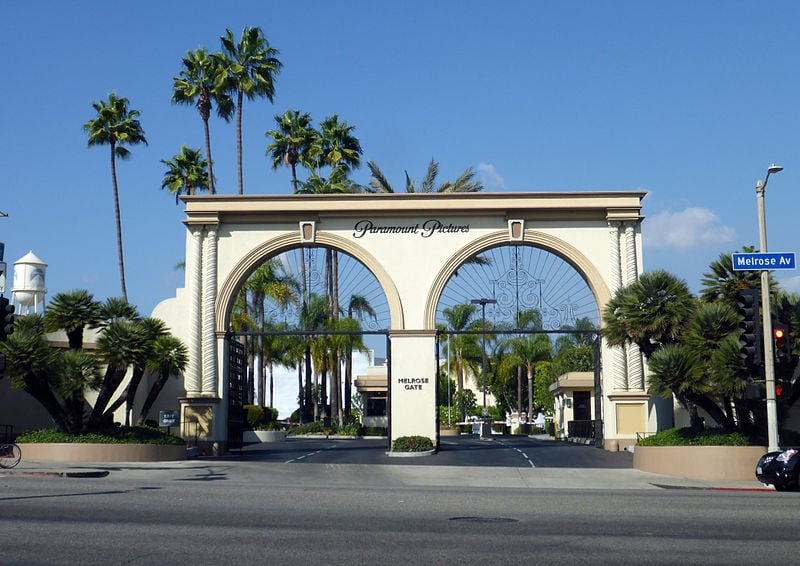
LA is getting a bona fide international fair week, just in time for Valentine's Day.

Janelle Zara

During the press preview for the inaugural edition of Frieze Los Angeles, director Bettina Korek shared an interesting fact: 49 of the fair’s 70 exhibitors had not shown at LA art fair in the past five years. Despite the city’s long tradition of cultivating great artists, it has been viewed as a peripheral blip on the global art-fair circuit. The main annual event has been the modestly sized, locally focused Art Los Angeles Contemporary. Other fairs—FIAC Los Angeles, Paris Photo Los Angeles, Art Platform Los Angeles, and Paramount Ranch—have fizzled, perhaps due to the city’s out-of-the-way geography and small collector base.
But despite these red flags, Frieze’s arrival on February 14 brings a newfound confidence in LA’s market potential—plus an unprecedented international art week. This year, Art Los Angeles Contemporary has rescheduled to coincide with Frieze, alongside newcomer Felix LA, a surprise LA edition of Spring Break, as well as the stART Up, Art in LA Affair, and Superfine fairs. Emphasizing their support for the local economy, the fairs strongly favor LA galleries and artists, and take place in such city-specific venues as a Hollywood movie studio, or by a pool.
The week also recasts LA’s role in the art world from a creative center to a commercial one, right as the sustainability of the current art-fair model for mid-sized galleries has come into question. In response, the new fairs are debuting a few different approaches, from tiered booth pricing to the elimination of the “emerging” label to interdisciplinary public programming. They’ve taken the city’s distance from the East Coast and European establishments as an opportunity to experiment—which for artists in LA has been a grand and longstanding tradition.
Here is what to expect from each fair.
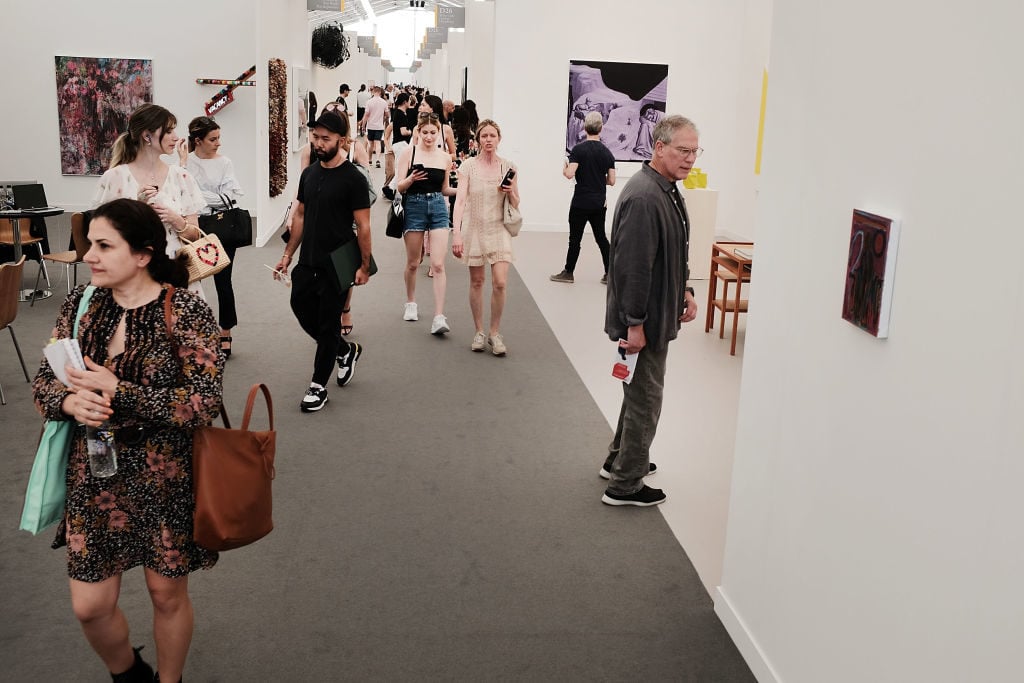
Last year’s Frieze Art Fair in New York. Photo by Spencer Platt/Getty Images.
Where: Paramount Pictures Studios, Hollywood
What’s different: For the first time, Frieze is implementing a four-tiered pricing structure across the fair. The price per square foot increases with booth size: a square foot of the smallest booth goes for less than 50 percent of that in the largest. An 859-square-foot booth, like Hauser & Wirth’s, for example, is priced at close to $80,000, while 10 smaller booths in the $10,000 range have been reserved for emerging to mid-sized LA galleries, including Commonwealth & Council, Hannah Hoffman, the Pit, and Anat Ebgi. Unlike in New York and London, where emerging galleries appear at Frieze under the “Frame” and “Focus” banners, respectively, the LA edition will not have sections.
How LA Is It? With Hollywood talent agency Endeavor holding a majority stake in the fair, the inaugural Frieze LA touts an unsurprising proximity to stardom. The galleries will be showing inside the familiar Frieze tent, but for this edition of Frieze Projects, curated by Ali Subotnick, a group of predominantly LA artists, including Barbara Kruger, Max Hooper-Schneider, and Sarah Cain are taking over Paramount’s outdoor New York City backlot with large-scale installations. One third of the 70 participating galleries are based in LA or have a space in the city.
Highlights: Mike Kelley’s Unisex Love Nest (1999), a full-scale recreation of a child’s bedroom, at Hauser & Wirth; a shared booth by Mexico City gallery kurimanzutto and Berlin’s Esther Schipper; film screenings, including those by Tala Madani and Wu Tsang; readings with Lisa Anne Auerbach’s psychic art advisor; Sarah Cain’s custom chocolate bars; and Karon Davis’s sculptural installation, GAME.
Tickets: $50 for full adult admission, $20 for the curated programming only, which includes backlot installations, talks, screenings, and Roberta’s pizza.
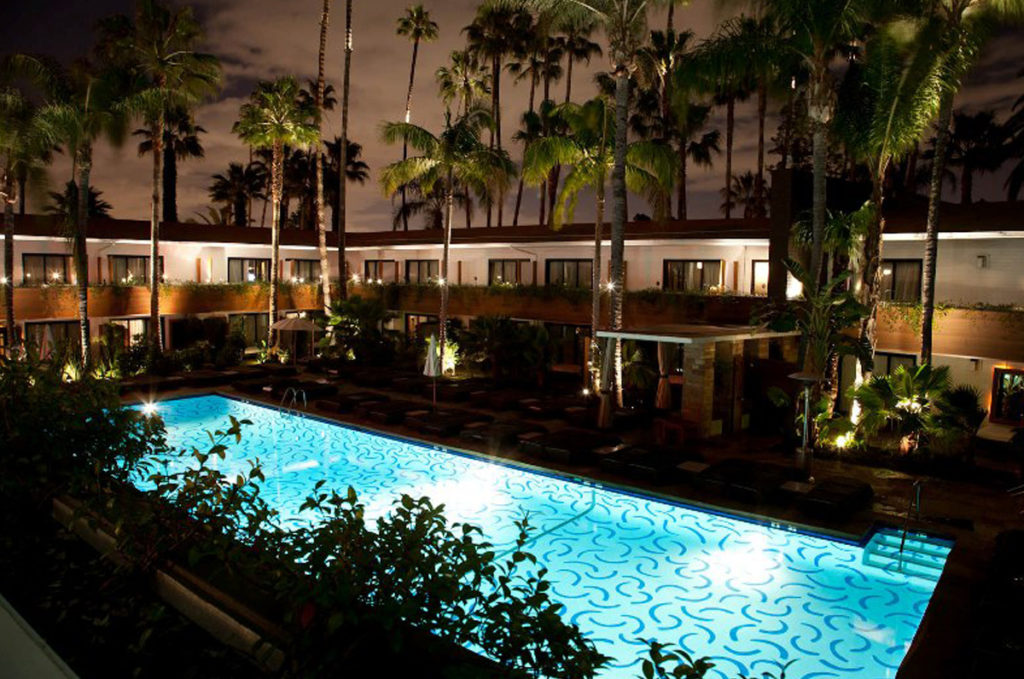
The pool at the Roosevelt Hotel, which David Hockney painted in 1988. Courtesy of Felix LA.
Where: The Roosevelt Hotel, Hollywood
What’s different: “Trying to make it as easy as possible for everyone to attend was important to us,” says Mills Morán of West Hollywood gallery Morán Morán, which partnered with Dean Valentine, a major local collector and former Walt Disney Television president, to organize the fair. Participation fees range from $4,000 to $8,000, capping out at $10,000 for the 13th-floor penthouse. Galleries range from New York’s Bortolami, Chicago’s Kavi Gupta, and LA’s Chateau Shatto. Veteran LA gallerist Susanne Vielmetter describes the context at Felix as “more fun and exciting,” compared to Frieze, where she’ll be showing a solo booth of works by Kim Dingle. At Felix, she strikes a different note with an “interactive record store from outer space” by illustrator-and-painter couple Esther Pearl Watson and Mark Todd.
How LA Is It? Valentine wanted to recapture the poolside vibe of the LA edition of the Gramercy International fair—the precursor to the modern-day Armory Show—which was held in the ’90s at the Chateau Marmont. In lieu of booths, the 38 participating galleries will occupy hotel rooms and cabanas overlooking the Roosevelt Hotel’s iconic David Hockney pool. Twelve are based in Los Angeles.
Highlights: Marc Selwyn’s presentation of artist Kristen Morgin’s ceramic self-help books, titled Jennifer Aniston’s Used Books; LA-based critic Andrew Berardini’s penthouse group show of French artists, including Laure Prouvost and Sonia Delaunay; Five Car Garage’s magic potions and elixirs; evening programming including film screenings, stand-up comedy, and live hip hop. As Valentine promised in previous interviews, paraphrasing John Baldessari, there will be “no more boring art panels.”
Tickets: Entry is free and open to the public.
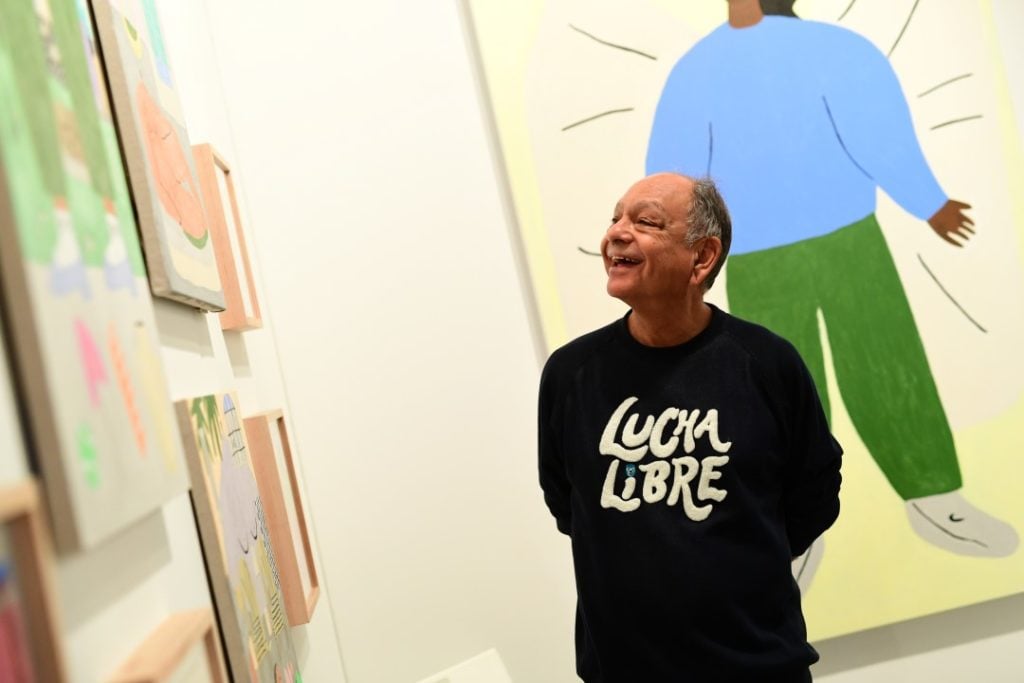
Actor and art collector Cheech Marin at the opening of Art Los Angeles Contemporary 2018. Courtesy of ALAC.
Where: The Barker Hangar at the Santa Monica Airport
What’s different: This year the fair has moved from its usual January time slot to coincide with Frieze. It also has a new visual identity, by artist Brian Roettinger; a new exhibition section called “The Academy,” curated by Berlin-based Claudia Rech; and a new interior design by architects Olson Kundig. With some of its biggest exhibitors having migrated to other fairs—David Kordansky, ihe Pit, and Anat Ebgi have all gone to Frieze, while Shane Campbell and Nicodim went to Felix—this edition sees an influx of emerging galleries from abroad. They’ve lowered booth prices to reflect this, with the smallest now set around $5,000. Freeways, a section formerly devoted to galleries six years old and younger, has been dissolved into the rest of the fair. “We’ve been growing up with Los Angeles as it becomes more of a commercial space for supporting artwork,” founder Tim Fleming says, as the city’s stronger collector base today attracts larger fairs. “We’re very curious to know how it all plays out, but nothing is as easy as it seems.”
How LA Is It? In past years, LA-based exhibitors have described the fair as a “fun party.” “All our friends are here,” Club Pro gallery founder Kyle Roberts once told artnet News. The fair launched 10 years ago with LA galleries comprising more half of its lineup, and its longtime home in Santa Monica is conveniently located near the collector enclaves of Venice and the Palisades. (Leonardo DiCaprio sightings are common.)
Highlights: Eric Wesley’s entire estate, offered by Bortolami, inside a recreation of the artist’s office at the fair (priced at $1 million); a conversation on the Fowler Museum’s exhibition “Inheritance: Recent Video Art from Africa” with curator Erica P. Jones and artists Zina Saro-Wiwa and Mikhael Subotzky; first-time galleries including Oslo’s VI, VII, Warsaw’s Pola Magnetyczne, and Auckland’s Starkwhite; returning galleries Shulamit Nazarian, Peres Projects, M+B, and Klowden Mann, with Peter Blake bringing a selection of works by Light and Space artists including De Wain Valentine.
Tickets: $75 for opening night, $25–30 for one-day passes
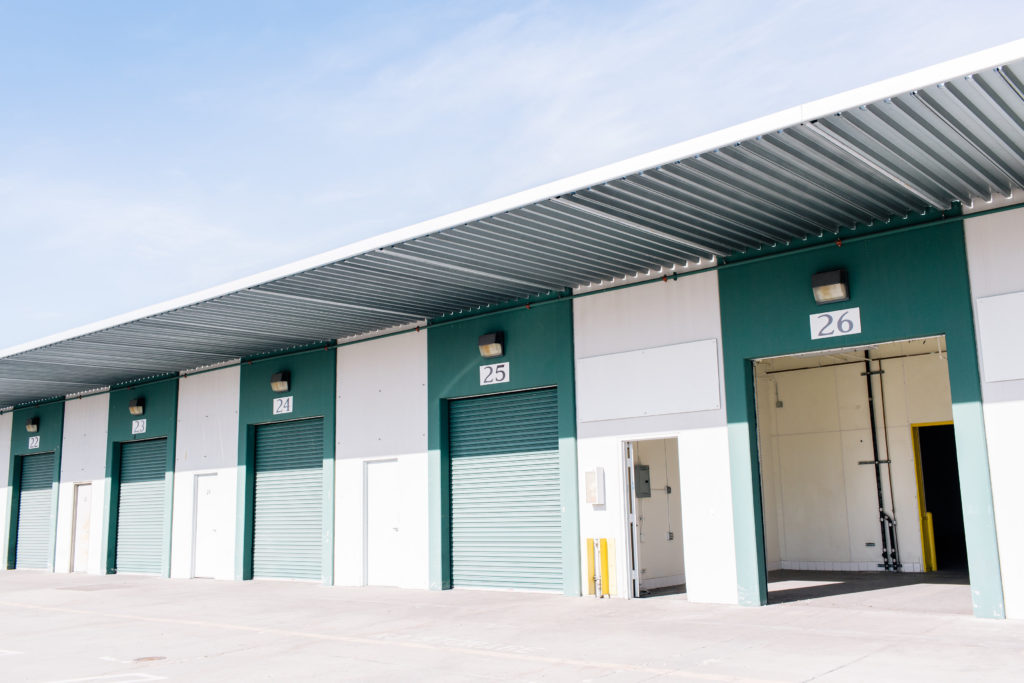
The Stalls at Skylight ROW, SPRING/BREAK’s downtown LA venue. Courtesy of SPRING/BREAK.
Where: The Stalls at Skylight ROW DTLA
What’s different: The fair is transplanting the successful model it pioneered in New York in 2012, offering curators a free space to exhibit within a disused urban building. Transactions take place online through the Spring Break site, which takes a final cut from the sales. But while the fair typically restricts curators from showing their own work, the LA edition opens the opportunity to local artists to exhibit themselves. “It’s giving them free space to be visible and have their part of the narrative during this massive international LA sales week,” says fair co-founder Andrew Gori. Spring Break’s curatorial theme for this year in both LA and later in New York is “Fact and Fiction,” described in a statement as, “this tug of war between real and unreal, symbolic and literal, fact and fiction, for-real and ideal.”
How LA Is It? With a handful of exceptions, the fair’s entire lineup of more than 40 participating artists, galleries, and curators is LA-based, taking place inside the stalls of an industrial former fruit market. Look for local artist-run spaces like Tin Flats, Elevator Mondays, and BBQLA, and non-profit organizations ProjectArt and Coaxial Arts. Surprise programming is scheduled to take place in the parking lot.
Highlights: Devin Troy Strother’s solo presentation of new works, and the fair debut of Galerie Maximus Oppenheimer, a new start-up space of a 16-year-old wunderkind.
Tickets: $20–35